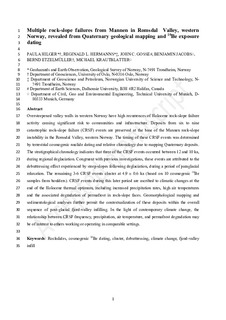Multiple rock-slope failures from Mannen in Romsdal Valley, western Norway, revealed from Quaternary geological mapping and 10Be exposure dating
Hilger, Paula; Hermanns, Reginald; Gosse, John C; Jacobs, B; Etzelmüller, Bernd; Krautblatter, Michael
Journal article, Peer reviewed
Accepted version
Permanent lenke
http://hdl.handle.net/11250/2586526Utgivelsesdato
2018Metadata
Vis full innførselSamlinger
Sammendrag
Oversteepened valley walls in western Norway have high recurrences of Holocene rock-slope failure activity causing significant risk to communities and infrastructure. Deposits from six to nine catastrophic rock-slope failure (CRSF) events are preserved at the base of the Mannen rock-slope instability in the Romsdal Valley, western Norway. The timing of these CRSF events was determined by terrestrial cosmogenic nuclide dating and relative chronology due to mapping Quaternary deposits. The stratigraphical chronology indicates that three of the CRSF events occurred between 12 and 10 ka, during regional deglaciation. Congruent with previous investigations, these events are attributed to the debuttressing effect experienced by steep slopes following deglaciation, during a period of paraglacial relaxation. The remaining three to six CRSF events cluster at 4.9 ± 0.6 ka (based on 10 cosmogenic 10Be samples from boulders). CRSF events during this later period are ascribed to climatic changes at the end of the Holocene thermal optimum, including increased precipitation rates, high air temperatures and the associated degradation of permafrost in rock-slope faces. Geomorphological mapping and sedimentological analyses further permit the contextualisation of these deposits within the overall sequence of post-glacial fjord-valley infilling. In the light of contemporary climate change, the relationship between CRSF frequency, precipitation, air temperature and permafrost degradation may be of interest to others working or operating in comparable settings.
